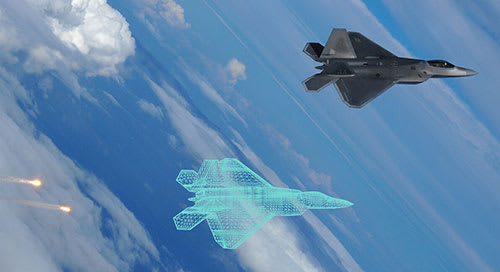How do you modernize the processing capability of an actively deployed aircraft to enable more efficient sensor data ingest and algorithm execution; while meeting an aggressive project schedule, maintaining the existing envelope, minimizing downtime and ensuring the aircraft passes qualification testing quickly? Early engagement and collaboration of Mercury architects and the customer were vital to designing a powerful electro-optical/ infrared (EO/IR) airborne processing solution able to deliver real-time intelligence.
Recommended

See how Mercury and Raytheon teamed up to design LTAMDS, a lower-tier air and missile defense sensor for the modern battlefield.
DRFM-based radar environment simulators and radar target generators are efficient, cost-effective solutions to methods validating radar systems and electromagnetic environment combat pilot training.

Next-generation modular RFSiP [radio frequency system-in-package] designs will introduce a new degree of freedom to address diverse signal-processing applications.

This article discusses a new generation of “Direct RF” data converters, revolutionizing system architectures across a wide class of platform applications and radio bands.
Image processing technology allows military aircraft to operate in past prohibited areas. Multi-sensor systems allow aircraft to operate in smoke, fog, snow, and heavy rain environments.
Discover how the U.S. Navy utilizes Mercury's scalable and configurable HD modular blade servers to simultaneously partition, process, and store adjacent levels of classified information.
PCIe 5.0 protocol benefits a new generation of rugged, deployable application platforms with doubled bandwidth and is an integral part of the latest devices from industry giants, Intel and NVIDIA.
Mercury’s RES HD servers provide the U.S. Navy with a secure, cost-effective, high-performing replacement for IBM blade servers.

Mercury supports the most critical application development with signal chain solutions from a single vendor that can be integrated with interchangeable tuners, data acquisition cards and recorder...

Today's pace of technology development means the traditional approach of custom-designed modules and subsystems is too slow, but Modular Open System Architecture (MOSA) approaches can deliver on...

Optimized to solve the most advanced radar, cognitive EW and AI challenges, learn how Mercury ’s ACAP-engineer-to-engineer designer’s journey is intended to assist other development teams.

SWaP-optimized and ruggedized for operation in harsh environments, learn how Mercury ’s ACAP-based solutions will bring new levels of application capability to the tactical edge.
COTS Software Defined Radio for 5G Development
AMD's new RFSoC brings a powerful and unique solution for addressing some of the most demanding requirements of high bandwidth and high channel count systems.
Development Tactics and Techniques for Small Form Factor RF Signal Recorders
PCIe Gen 4 technologies increase application efficiency by eliminating bottlenecks and increasing throughput for multi-domain, compute-intensive applications at the edge.
This whitepaper discusses how new holistic systems security engineering and flight-safety certification design approaches are enabling smarter platforms to be deployed anywhere.
This paper first discusses advanced capabilities that enhance LCD technology and then reviews business factors to consider when selecting or specifying display systems.
This white paper describes AI and cognitive computing (CC) and introduces the underlying largely commercially developer IP that enables them.
Commercial digital convergence has created converged media, information systems, smartphones and autonomous vehicles. Digital convergence now has a proven roadmap behind it and is enabling...

